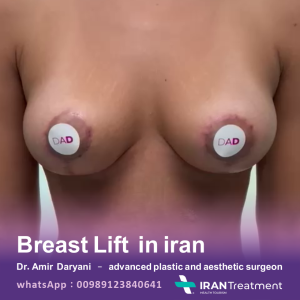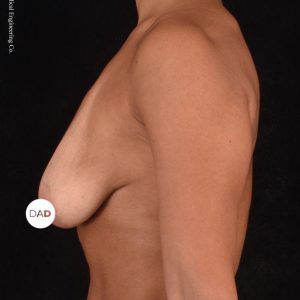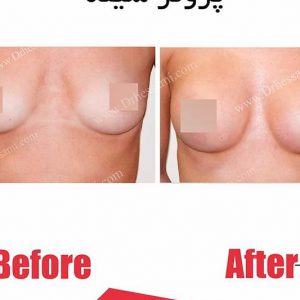Breast reduction in Iran
Breasts not only give women feminine appearance, but also play an important role in their confidence. Of course, these organs, which consist mainly of adipose tissue, are not always satisfactory to women. Although breast enlargement has recently been a relatively common operation, in some women the big size of the breasts is an uncomfortable factor and sometimes it may even lead to breast cancer. That’s why it’s not bad to know about Breast reduction in Iran surgery.
The size reduction and breast shaping (reducing mammoplasty) surgery is a common plastic surgery. Women with very large breasts may also have physical problems in addition to being dissatisfied with the size and shape of their breasts. These include neck and back pain, irritation and inflammation of the skin under the chest and discomfort during exercise. Breast enlargement has a significant adverse effect on self-esteem and women’s participation in social activities. Breast enlargement is most common in women after childbirth, but in single girls it is due to illness or hereditary conditions. In this surgery, by removing part of the adipose tissue and the glandular tissue of the breast and skin, the breasts will look firmer, smaller and rounder. This not only reduces the size of the breasts, but also improves the shape of the breasts. Breast reduction in Iran is recommended for both women and men with gynecomastia. The whole purpose of this procedure is to create breasts that fit the rest of the body.
You should know about all the possible risks and complications before mammoplasty and discuss your true expectations with your doctor. Reduction surgery may improve your appearance and ability to engage in physical activity.
Mammoplasty surgery is not recommended in this conditions:
- Certain conditions such as diabetes or heart problems
– In very obese people
– Any disease that causes a problem in the chest
You can use mammoplasty at any age and this can sometimes be done as a teenager, depending on the circumstances. But if your breasts have not yet fully grown, you may need a second surgery.
If you have specific plans in the future, you may need to delay breast reduction surgery
like:
giving birth
If you are planning on getting pregnant, you may want to delay the mammoplasty so that it does not cause any problems. This is because after surgery, you may have trouble breastfeeding. However, some surgical techniques can help maintain your ability to breastfeed.
Weight Loss
If you want to lose weight, change your diet or start a workout routine, you should delay mammoplasty and consult your doctor. Under these circumstances, losing weight can often lead to a change in the size of your breast.
The procedure for Breast reduction in Iran surgery varies from person to person and should be determined according to the physical condition, breast condition, excess fat, patient’s desire and physician recommendation.
Stages of mammoplasty:
Stage One – Anesthesia
Medications are prescribed for the comfort of the patient during breast reduction surgery. You may need intravenous sedation or complete anesthesia for this surgery. The method of anesthesia is chosen at the discretion of the physician.
Stage two – Cutting the skin
There are different patterns of surgical incisions for women:
Ring cut around Areola (brown skin around nipple)
Circular incision around Areola and continue incision vertically upwards
Inverted T cut
The surgical incisions remain hidden under the bra and bathing suit.
Stage Three – Extraction of tissue and breast deformity
After the incisions are made, the position of the nipple changes; however, the nerves and the nourishing veins are preserved. If needed, Areola with peripheral skin incision gets smaller. The underlying tissue is removed, lifted, and shaped. In cases where the breasts are too large, it may be necessary to remove the nipple and Areola from their location and transplant to a higher site (nipple transplant).
Stage Four – Stitches
The surgical incisions overlap and the breast becomes smaller in size. The sutures are deeper into the breast tissue to create and maintain the new shape of the breasts. The sutures, the skin glue and surgical tape completely adhere the incision. The scars will improve significantly over time.
Step Five – Results
The surgical results of the female Breast reduction in Iran are visible immediately after the end of surgery. Over time, the swelling after surgery has also been resolved and the scars have been faded. Satisfaction with the results of surgery is achieved by undergoing post-surgical recovery.
The best candidates for this surgery
If one has one or more of the following, they are a good candidate for mammoplasty.
– Very large breasts that do not fit the structure of the person’s body
- Back, neck or shoulders pain due to excessive breast weight
- Asymmetric breasts (meaning one breast is clearly larger than the other).
- Inflammation and skin infection
– Pleas under the breasts
– Restrictions on physical activity and sports due to the size and weight of the breasts
- Bra strap lines on the shoulders
- Dissatisfaction with the size of the breasts
Age appropriate for surgery
The procedure is applicable at any age, but it is recommended that it is done after breast development.
Preparation for mammoplasty surgery
Before your plastic surgeon’s mammoplasty will probably check:
– Evaluation of medical history and overall health
– Consult your expectations after mammoplasty surgery
– Possibility of scarring and numbness
– Check the status and size of the breasts
– Take pictures of your breasts for medical records
– Explain the type of anesthesia used in surgery
Before performing mammoplasty, it is recommended that you:
– Complete various laboratory tests
– Get a basic mammogram
- Avoid smoking before and after surgery
- Avoid taking aspirin, anti-inflammatory drugs and herbal supplements to control bleeding during surgery.
Risks and complications of mammoplasty surgery:
Although this is not a simple surgery, fortunately the major complications are not common. Some of the complications are:
– Reduced ability to breastfeed
– Scars (described above)
– Asymmetric breasts
– possibility to decrease nipple sensation
- Infection and bleeding (These are possible complications of any surgery)
Postoperative recommendations
In the first few days after surgery, bending and lifting should be avoided. Because it can exacerbate swelling and even bleeding. It is best to use a special bra for a few weeks after the operation to relieve the swelling. The suture is gradually removed with your surgeon’s opinion one week to 14 days after surgery.
Does this surgery lessen the risk of breast cancer?
Logically, due to the reduced size of the breast tissue, the risk of cancer after surgery is reduced, although this possibility has not yet been established. It is advisable to have a mammogram before the surgery to check for breast cancer. Mammography (radiologic breast imaging) is performed annually along with mammography by the surgeon as well as 6 to 8 months after surgery to re-examine the breasts.
Restarting your daily activities
Depending on the patient’s occupation, most patients are able to return to work after 2 weeks, but it is generally recommended that serious breast care be provided for up to 6 months. In the end, it is best to consult with a plastic surgeon about breast changes before deciding to have a Breast reduction in Iran surgery so the surgeon can better understand your realistic goals.
Answers to Frequently Asked Questions About Breast Surgery (Mammoplasty)
۱. What is the severity of chest pain after surgery?
The pain is not severe, but there is pain. The amount of pain depends on the volume of tissue removed and the surgery. But overall, an average amount of pain is waiting for you.
۲. How long does it take to achieve complete recovery?
Usually, it takes about 3 weeks for a complete recovery.
۳. Is there any possibility of anemia after this surgery?
No, you should not have anemia after this surgery. The volume of blood that exits your body during this operation is up to 500 cc, which will not cause anemia
Breast lift
Breast lift
Breast lift







